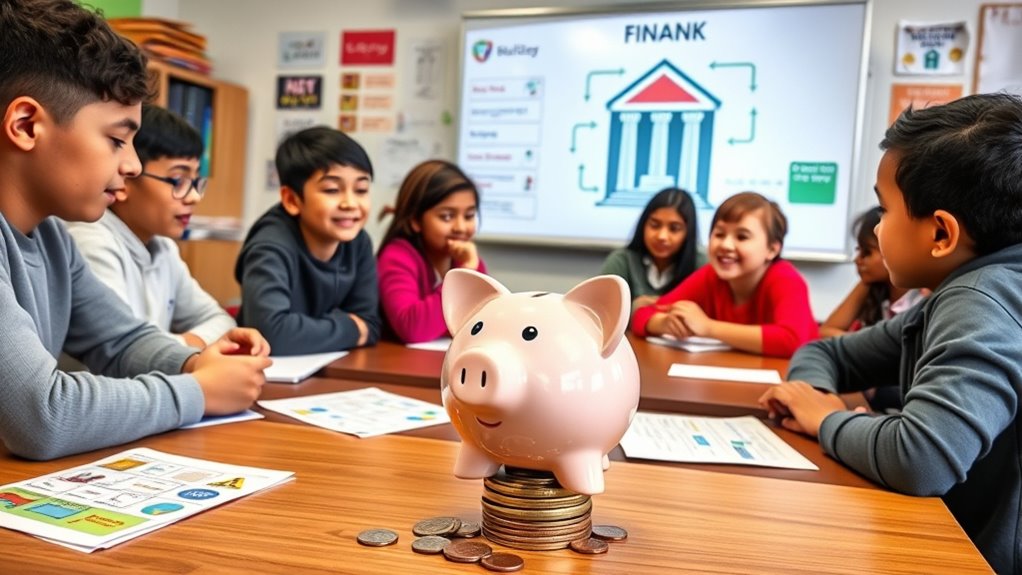Teaching kids about money management is essential for their future. It empowers them to make informed decisions and manage resources wisely. Begin with basic concepts like saving and spending as early as preschool, then gradually introduce banking, budgeting, and investments through age-appropriate lessons. Engage them with hands-on experiences to reinforce these skills. Instilling financial literacy early helps children navigate economic challenges later. Discover practical methods to enhance their financial journey further.
Key Takeaways
- Start financial education early by introducing basic money concepts through play for preschoolers and practical activities for older children.
- Teach children to differentiate between needs and wants, fostering informed spending decisions and budgeting skills as they grow.
- Encourage saving through visual tools like jars and set specific savings goals to instill delayed gratification.
- Introduce banking services and concepts like interest to middle schoolers, preparing them for responsible money management.
- Engage children in real-world financial scenarios and discussions to reinforce lessons and build confidence in money management skills.
The Importance of Financial Literacy for Children

Financial literacy is essential for empowering children to navigate their financial futures confidently. When you teach kids about money, you’re equipping them to make informed decisions and manage resources effectively. This not only fosters critical life skills like problem-solving and decision-making but also instills the value of delayed gratification. Early financial education helps them avoid the pitfalls of debt and mismanagement, laying a solid foundation for their economic stability. By developing responsibility and accountability, children learn to understand the financial consequences of their actions, further solidifying their ability to manage money effectively. Studies show that children who engage in nighttime meditation can improve their focus and decision-making skills, which may also benefit their financial planning. Additionally, learning to set SMART goals provides a structured approach for children to achieve their financial objectives. As they learn to set goals and plan for the future, they develop a stronger sense of purpose. Ultimately, you’re helping them build the knowledge and skills necessary for personal success, enhancing their economic confidence and preparing them for a prosperous future. Engaging in financial education also fosters emotional resilience, equipping them to cope with challenges related to money management. Furthermore, understanding the importance of retirement savings can help children grasp the value of long-term financial planning from an early age. Teaching them about common financial mistakes can also help children develop critical thinking skills necessary for avoiding pitfalls later in life.
Age-Appropriate Financial Lessons for Different Stages

As children grow, their understanding of money evolves, making it important to tailor financial lessons to their developmental stages. For ages 4-7, introduce basic concepts like different forms of money and use play-based learning with pretend stores. Encourage saving habits through labeled jars and allow them to make simple decisions to grasp trade-offs. Additionally, roleplay with toy cash registers can further enhance their understanding of real-life transactions. Incorporating gentle methods of teaching can help reinforce these lessons in a supportive way. It is also beneficial to create a safe sleep environment that fosters a sense of security, as this can positively impact their overall well-being. Teaching them about the 50/30/20 rule can also provide a simple framework for understanding how to allocate money effectively as they grow older.
From ages 8-12, focus on budgeting basics, distinguishing needs from wants, and setting specific savings goals.
At ages 13-15, open a student account and discuss credit awareness and earning potential.
Finally, for ages 16-18, prepare them for financial independence by introducing credit cards, budgeting skills, and investment basics. Each stage builds a solid foundation for their financial future.
Engaging Preschoolers With Money Concepts

How can you make learning about money fun for preschoolers? Start by using sensory experiences to introduce coins and notes, helping them become familiar with currency. Utilize visual aids like flashcards and charts for recognition. Engage them in role-playing with play money to teach the value of money. Incorporate counting games that involve coins to build basic math skills. Teaching money in a fun and engaging way helps foster a positive attitude towards financial literacy from an early age. Additionally, introducing concepts of budgeting can help them understand how to manage their money wisely. Pretend shopping scenarios and playing “bank” can reinforce their understanding of transactions and deposits. Set up a mini grocery store or restaurant to practice budgeting and prices. Teaching them about newborn feeding options can also provide a practical context for understanding expenses. Activities like coin bingo and Play-Doh imprints deepen their grasp of coins. It’s also beneficial to teach them about saving early to help instill the importance of saving. Moreover, regular exercise can promote overall well-being, which is essential for maintaining focus during learning activities. Finally, encourage saving with a piggy bank to instill the importance of saving early on. Additionally, discussing financial choices in a family setting can create a supportive environment for good grief and healthy emotional processing.
Establishing Money Management Routines in Elementary School

Establishing money management routines during elementary school sets the foundation for lifelong financial skills. Start by introducing the value of money through chores, allowing your child to earn their allowance. Teach them to recognize different currencies and make basic spending decisions, distinguishing between needs and wants. Use savings jars to visualize their savings progress and set achievable savings goals. Involve them in family budget discussions to foster understanding. Additionally, consider incorporating auditory feedback therapy techniques into financial discussions to enhance their listening and comprehension skills. Incorporate financial literacy into math and reading lessons, using engaging games and activities. By utilizing predictive modeling techniques, educators can better tailor financial literacy lessons to meet the diverse needs of students. Teaching children about Roth vs. Traditional IRA options can also instill an early understanding of saving for the future. Encourage them to allocate funds into spending, saving, and sharing categories. By instilling these routines, your child will learn essential skills for managing money responsibly and making informed financial decisions. Additionally, knowledge of money management can help children overcome socioeconomic challenges, further emphasizing the importance of these early lessons. Teaching children to manage their earnings from chores can help them understand the concept of budgeting basics, laying the groundwork for sound financial habits. Moreover, fostering a sense of mindfulness during financial discussions can enhance their understanding and appreciation of the value of money.
Exploring Banking and Interest for Middle Schoolers

What’s the best way for middle schoolers to grasp the concepts of banking and interest? Start by introducing them to banking services like savings and checking accounts.
Explain how savings accounts earn interest, helping their money grow over time. Interest rates can vary, so it’s important for them to understand how this affects their savings. Encouraging them to develop good savings habits, setting aside money for future goals like college, will help them maximize retirement savings. Learning money basics provides more options for them in their financial journey. Additionally, understanding the concept of compound interest can further motivate them to save consistently. Teaching them about the benefits of gold investments can also provide insight into alternative ways to grow wealth. Furthermore, introducing them to efficient payment solutions can help them understand how technology streamlines financial transactions.
Use tools like debit cards to teach them about managing spending and tracking transactions with guidance. Real-life scenarios and apps can make learning about banking fun and relevant.
Programs like Hands on Banking provide valuable resources, making these concepts easier to understand. By combining practical applications with engaging lessons, you’ll help them build a strong foundation in banking and interest that lasts a lifetime.
Investment Basics and Credit Responsibility for High School Students

Learning about investments helps you grasp ownership through stocks and the benefits of mutual funds or ETFs for diversification. By spreading your investments across different areas, you can balance risk and reward. A long-term approach, like “buy and hold,” allows you to ride market fluctuations. Understanding the divorce process can also provide insights into managing financial responsibilities during significant life changes.
Understanding investments fosters ownership through stocks and diversification with mutual funds or ETFs, helping balance risk and reward.
On the credit side, knowing your credit score impacts loan eligibility and interest rates. You need to manage debt wisely to avoid overspending and financial pitfalls. Understanding the differences between credit types helps you make informed choices. Setting budgets and recognizing financial scams will safeguard your future, making financial literacy vital for your success. Additionally, having knowledge of Gold IRA rules can provide valuable insights into alternative investment options as you consider your financial future.
The Role of Hands-On Experience in Financial Education

While traditional classroom instruction has its merits, hands-on experience greatly enhances financial education by actively engaging students in real-world scenarios. This method proves more effective than lectures, helping you retain financial concepts better.
Programs like My Classroom Economy allow you to practice financial management in a simulated environment, building your confidence in making decisions later in life. You’ll find that engaging in these activities with parents reinforces lessons, making the knowledge stick.
As you learn to manage your allowance or participate in programs like the Budget Challenge, you develop essential skills like saving and budgeting. Ultimately, these real-time experiences lead to positive financial behaviors and a greater sense of financial self-efficacy, setting you up for long-term success.
Key Financial Concepts Every Child Should Learn

Financial literacy is an essential skill that every child should learn early on to navigate the complexities of money management.
Start by teaching them about saving a portion of their allowance and the importance of budgeting. Encourage them to earn money through chores to grasp its value and differentiate between needs and wants.
Help them set financial goals and allocate funds wisely. Introduce basic banking concepts and payment methods, along with the idea of interest and taxes.
Discuss smart spending habits and the implications of debt. By exploring these key financial concepts, you’ll prepare your child for a future of responsible money management and informed financial decisions.
The Long-Term Impact of Financial Literacy on Adult Life

Teaching kids about money management lays the groundwork for their future success. When you instill financial literacy early on, you’re reducing the chances of excessive debt accumulation. Kids learn to make informed decisions about borrowing and spending, which enhances their savings habits.
As they grow, mastering budgeting skills helps them manage resources effectively, ensuring financial stability. Financial literacy also encourages investment knowledge, leading to greater wealth over time.
Furthermore, understanding financial principles allows for better career choices and effective planning for life milestones. By fostering financial independence, you equip them to make sound decisions without relying on others.
Ultimately, this knowledge reduces financial stress, paving the way for healthier relationships and increased self-confidence throughout their adult lives.
Addressing Challenges in Current Financial Education Systems

As schools increasingly recognize the importance of financial literacy, they face numerous challenges in implementing effective programs. Only half of U.S. states include personal finance in high school curricula, leading to gaps in knowledge.
Underfunding exacerbates disparities, making it tough to provide quality education across diverse communities. You might notice that many educators lack the training to teach financial skills effectively, and existing programs often fail to engage students, resulting in low retention.
Additionally, without standardized frameworks, evaluating program effectiveness becomes tricky. Access to technology also poses barriers, particularly for underserved populations.
To address these issues, schools must prioritize collaboration, create engaging content, and guarantee equitable access to financial education for all students.
Frequently Asked Questions
What Resources Are Available for Teaching Kids About Financial Literacy?
You’ve got plenty of resources to teach kids about financial literacy!
Apps like Zogo, Greenlight, and MoneyTime gamify learning, making it fun and engaging.
Books such as “Rebel Girls Money Matters” and “Rich Dad Poor Dad for Teens” provide valuable insights.
Online, platforms like Khan Academy and Biz Kid$ offer interactive courses and videos.
Don’t forget community workshops and educational guides that can enhance your teaching experience and help kids grasp essential money concepts!
How Can Parents Encourage Financial Discussions at Home?
Imagine money as a conversation starter, sparking curiosity and engagement in your home. To encourage financial discussions, you can openly share your own experiences with money, creating a safe space for questions.
Initiate conversations regularly, using everyday situations to discuss expenses or saving. Involve your kids in budgeting, letting them see decision-making in action.
What Are Common Misconceptions About Money Among Children?
You might notice that kids often have misconceptions about money. They may think it magically appears, like from an ATM, without limits.
Many believe credit cards are free money, failing to understand the need to repay them. They might equate money with happiness, assuming it can buy anything.
Additionally, kids often think saving isn’t important or that financial topics are too complex for them. These beliefs can hinder their understanding of money’s true value.
How Can Technology Assist in Teaching Financial Literacy?
Technology’s got your back when teaching financial literacy.
With interactive apps and games, you can make learning fun and engaging. Customizable features let you learn at your own pace, while online resources provide diverse materials.
Tools like budgeting apps help you track spending and set savings goals. Plus, real-world simulations give you a taste of managing finances.
It’s all about making complex concepts easy and accessible for you!
What Role Do Peer Influences Play in Kids’ Financial Habits?
Imagine a garden where each plant represents a friendship, growing together under the sun.
Just like these plants, your financial habits can flourish or wither based on the peers you surround yourself with.
If your friends value saving, you’re likely to adopt similar habits. Conversely, if they prioritize spending, you might find yourself caught in a cycle of consumerism.
Peer influence shapes your money mindset, pushing you toward either financial growth or stagnation.
Conclusion
By teaching kids financial literacy, you’re planting seeds that can blossom into lifelong money management skills. As they navigate the world of finances, these lessons can help them grow into responsible adults who make informed decisions. Remember, it’s not just about saving pennies; it’s about building a strong foundation for their future. Embrace the journey of financial education, and watch as your children thrive in their understanding of money, turning them into savvy stewards of their own success.









